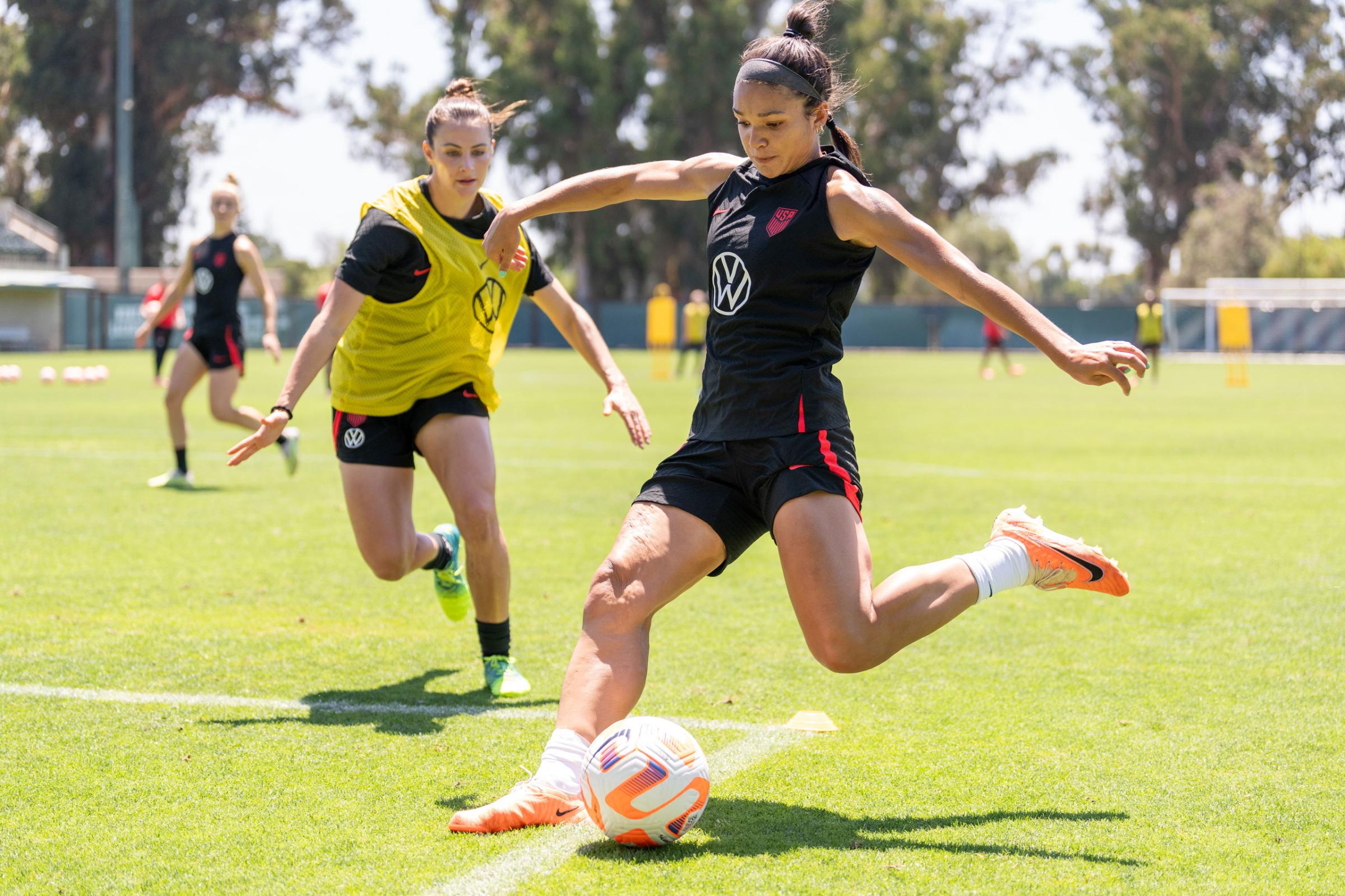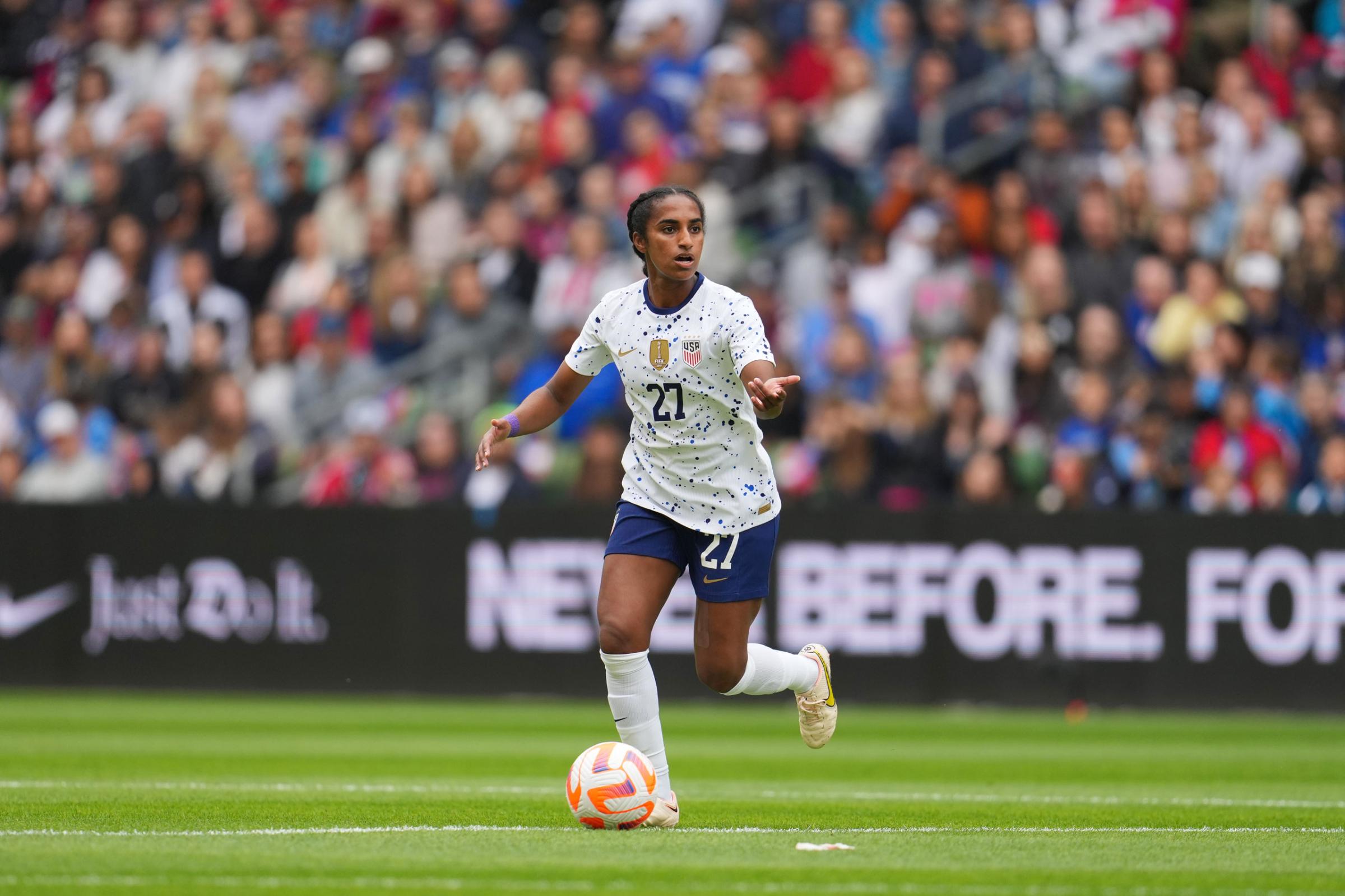Generational behaviors often confound the members of the 2023 U.S. Women’s National Soccer Team (USWNT). In that sense, the USWNT locker room is not unlike most modern-day American workplaces. While older players scoff at the habits of the near-teenagers on the squad, with their TikToks and uses of phrases like “rizz”—that’s Gen Z shorthand for charisma—the young guns find the oldheads just as baffling.
“Some of the songs they’re all listening to, I have no idea what they are,” says U.S. forward Sophia Smith, 22, the reigning National Women’s Soccer League (NWSL) MVP who will make her World Cup debut on July 21, when the U.S. kicks off its group-stage campaign against Vietnam in Auckland, New Zealand. “They sound like my parents.”
According to Smith, the elder American soccer players will drone on about the technology they used back in the old days. “Like the CD player,” says Smith, who leads the NWSL in goals scored this season. “Stuff that I just don’t know.” Smith has learned that at one time, googling wasn’t a verb: other internet search sites existed in the pre-Google era. “So odd,” she says. And forget about their fondness for ancient cultural artifacts. “I won’t watch any movie,” says Smith, “that’s grainy.”
Read More: Your Guide to the 2023 Women’s World Cup
The USWNT is seeking history this summer, in trying to become the first team—women’s or men’s—to three-peat at a World Cup. But after stirring victories in 2015 in Canada and four years ago in France, America is a team in transition. Their ages range, in the words of Alex Morgan, “from 18 to Pinoe.” Established superstars like Megan Rapinoe, 38, and Morgan, 35—who along with defender Kelley O’Hara, 34, are making their fourth World Cup appearance—will provide veteran leadership and firepower; Morgan, in particular, appears in top form. At the same time, the team will feature 14 newcomers, including young front-line players like Smith, Trinity Rodman, 21, and prodigy Alyssa Thompson, 18. No USWNT squad has experienced more turnover between World Cups. Morgan is about to make her 207th national-team appearance. Midfielder Savannah DeMelo, 25, will make her first.
More than ever, the team reflects the diversity of the country it represents. There are nine women of color on the roster—including seven Black women—a welcome development considering that soccer has traditionally been a mostly white sport in the U.S.

Blending World Cup experience with rookie legs—and potentially nervous brains, facing the global glare of the World Cup for the first time—will determine America’s fate at the tournament, being held for the first time in two countries: Australia and New Zealand. As is their wont, the American women—who after all are four-time World Cup champions and still the betting favorite—exude nothing but confidence. Midfielder Kristie Mewis has a unique view. At 32, she identifies as an older player. But she’s playing in her first World Cup, so she may face the same challenges as her younger compatriots. “The fresh faces and fresh energy,” says Mewis, “but also the wisdom and experience that the older players have, the combination is going to be deadly.”
U.S. vs The World
What a difference four years makes. Going into the 2019 World Cup in France, the USWNT players were suing their bosses. The team’s fight for pay equal to that of their male counterparts dominated headlines leading up to the tournament. While that lawsuit galvanized a movement for pay equality, both within the United States and beyond its borders, the case did add a layer of stress to the World Cup effort. What’s more, the team’s star player, Megan Rapinoe, became embroiled in a Twitter-spat with then President Donald Trump.
In the U.S., the women achieved its pay-parity victory last year, when the players signed an historic collective bargaining agreement (CBA) with U.S. Soccer that guarantees the women equal payments for international competition, and evenly splits FIFA World Cup prize money for women and men players. And a verbal war with President Joe Biden, who helped reveal the World Cup roster in June and awarded Rapinoe the Presidential Medal of Freedom a year ago, seems highly unlikely.
So the team enters the World Cup facing fewer distractions. Still, the USWNT remains under intense pressure. Anything less than a third straight title counts as a monumental failure.
“You didn’t see it when we walked in?” Rapinoe responded, at the team’s June media day in Los Angeles, when asked if the players felt they had a target on their back. “Still there. Always there.”
What’s more, the rest of the world has reason to puff its chest. Soccer-mad nations outside the U.S. have finally figured out that investing in women pays off. Last year’s European Championship, for example, was a stunning success. England won the tournament on home soil, and the event set viewership and attendance records. England then knocked off the U.S. in a friendly at Wembley Stadium in October. The U.S. also lost to Spain and Germany, handing the Americans their first three-game losing streak since 1993.
How do the experts feel about a U.S. three-peat? “God, it’s going to be hard,” says former U.S. star Julie Foudy, an ESPN analyst. “If you have a world that’s catching on to the power of girls playing soccer and the beauty of that, from here on out, I think it is going to be a tough slog for the U.S.”
The Injury Toll
The USWNT rallied in early 2023, sweeping Brazil, Canada, and Japan on their home turf in the SheBelieves Cup. But they’ve been bitten by the injury bug. Mallory Swanson started 2023 on an absolute rampage. She entered the team’s April 8 friendly against Ireland leading the U.S. in goals on the year, with seven. “She’s just been on a heater,” Rapinoe said at that time. Swanson, however, tore her left patella tendon in the game and is out for the World Cup. An ACL tear felled the World Cup hopes of another promising U.S. attacker, Catarina Macario.
Read More: How the Women’s World Cup Evolved Into What It Is Today
Injuries have also riddled the midfield. Rose Lavelle’s spectacular charge up the field in the 2019 World Cup final against the Netherlands—and the resultant goal—put the game away for the Americans. The breakout star, however, has been nursing a knee injury. And on defense, the Americans suffered a setback: veteran center back Becky Sauerbrunn, a captain, two-time World Cup champion, and one of the leaders of the team’s equal-pay fight, will miss the World Cup as she continues to rehab from a foot injury.
The U.S. is not the only World Cup contender dealing with injuries. England forward Beth Mead, one of the world’s best, is not on the World Cup roster due to an ACL injury. Neither is Leah Williamson, a key defender for the Lionesses. The Netherlands (Vivianne Miedema) and France (Marie-Antoinette Katoto and Delphine Cascarino) are also missing key players.
The Replacements
Naomi Girma, 23, is the only player ever to win both rookie of the year and defender of the year in the NWSL. She won a national championship at Stanford in 2019, her sophomore year (Smith was also on that team). Now she’ll be called upon to fill Sauerbrunn’s shoes and anchor the U.S. defense.
“There’s very few players in my whole tenure that have stepped in and it’s just like, ‘Oh yeah, that’s a first-person-on-the-team sheet type of player’ every single time … she’s just that good,” Rapinoe said about Girma earlier this year. “I don’t think her physicality gets talked about enough, deceptively quick. If you have any kind of quickness and brain, then that’s a wrap. She can play any kind of ball. She’s a great leader. She’s just f-cking good.”

Read More: Megan Rapinoe Won Equal Pay. Now She Wants to Win Her Last World Cup
The Americans will have to rely on their forward depth to make up for the absence of Swanson and Macario. Four World Cup rookies—Smith, Lynn Williams, 30, Trinity Rodman, 21, and Alyssa Thompson, 18—join Morgan and Rapinoe up front. Thompson missed her high school graduation this year, since she had to suit up for a NWSL game, for Angel City FC.
“I’m excited about the energy and the enthusiasm that the young players bring,” says U.S. coach Vlatko Andonovski. “That will be one of our advantages.”
A More Diverse Squad
As will its mix of players. This USWNT World Cup roster is the most racially diverse in the team’s history. The team’s World Cup rookie forward core consists entirely of Black women. “Diversity is extremely important,” says Rodman, who does not recall as many women of color playing when she was a kid. It opens the eyes of girls who might not have seen themselves in the game before, she says.
Girma is the daughter of Ethiopian immigrants. She also says that diversity “is not something I saw” in professional soccer or on the U.S. national team when she was growing up. “We’ve talked about how important representation is,” he says. “It’s really inspiring, and it’s going to make this team and this World Cup special.”
Defender Sofia Huerta, 30, played for the Mexican national team when she was younger. Her father Mauricio was born in Mexico and studied electrical engineering there before moving to the U.S. She gave up her spot, however, in order to try to make the U.S. team. After being cut in 2019, Huerta was picked for this year’s squad. “I had a lot of conversations with my dad and I felt like it was possible if I picked the U.S., and I had Huerta on the back of my jersey, that little boys and girls could see the Hispanic last name,” she says. “If you could see it, you can be it.”
Next Woman Up
As the USWNT enters this transitional World Cup, the players are well aware of the pressing questions. Are the older players past their primes? Or the younger ones ready? Is this U.S. team just too banged up—and the rest of the world just too talented—for fans to count on that third straight title?
“This team has always gone through cycles and changes,” says U.S. defender Alana Cook, another World Cup rookie who, along with Girma, is expected to play a key role on the back line. “It’s always the next-woman-up system. When it’s your turn, you have to be ready. Whether you’re starting or not one game, you’re always ready for the next one because you’ve listened, you’ve learned. So younger players coming in isn’t a bad thing. I think it’s just a testament to how hard the veterans have worked to make sure that the things that we have, the culture, the work ethic, the tactics, are ingrained in all of us.”
The whole team knows to leave all excuses back home this summer. “Would I be happy with anything short of a third straight win?” says Andonovski. “No. Absolutely not. There is only one thing in mind when going to this tournament: our goal is to win the World Cup. There’s no question about it. And I don’t think that anyone on our team thinks anything different.”

TIME will be providing ongoing coverage of the 2023 World Cup, which takes place from July 20 to August 20 in Australia and New Zealand. Subscribe to TIME’s World Cup Newsletter, “Extra Time,” here.
More Must-Reads from TIME
- Cybersecurity Experts Are Sounding the Alarm on DOGE
- Meet the 2025 Women of the Year
- The Harsh Truth About Disability Inclusion
- Why Do More Young Adults Have Cancer?
- Colman Domingo Leads With Radical Love
- How to Get Better at Doing Things Alone
- Michelle Zauner Stares Down the Darkness
Write to Sean Gregory at sean.gregory@time.com